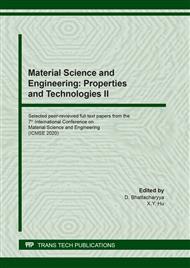p.3
p.13
p.19
p.25
p.33
p.39
p.45
p.51
Analysis of Precipitates in Welded Joint of TP347H Stainless Steel
Abstract:
The precipitates in welded joint heat affected zone (HAZ) and base metal of TP347H stainless steel were observed and analyzed by SEM, TEM and EPMA. The results show that precipitate of NbC can be observed in welded joint HAZ in as-welded, and more NbC precipitate in high temperature service. The size of primary NbC in base metal ranges from tens of nanometers to hundreds of nanometers, but only tens of nanometers of the precipitated NbC. The fine precipitate of NbC is mainly distributed in the crystal, however, continuous distribution of NbC is also observed on the grain boundary of the service joint. Cr carbide precipitates at the grain boundary, and some of particles distribute continuously on the grain boundary after service. The fine NbC precipitated in the crystal strengthens the matrix, and the continuous distribution of Nb and Cr carbides on the grain boundary reduces the interfacial bonding strength, then both of which result decrease of the material plasticity.
Info:
Periodical:
Pages:
25-30
Citation:
Online since:
April 2021
Authors:
Keywords:
Price:
Сopyright:
© 2021 Trans Tech Publications Ltd. All Rights Reserved
Share:
Citation:


